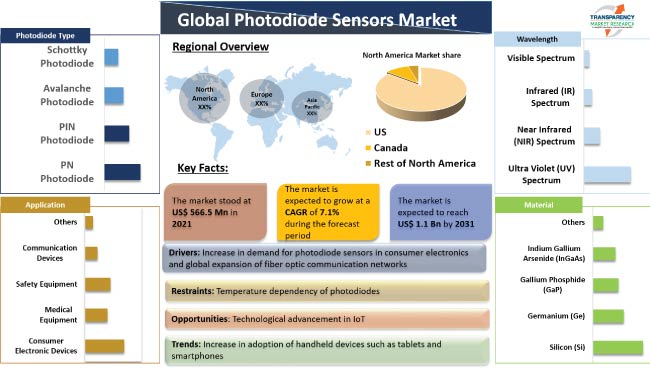
Global Photodiode Sensors Market – Snapshot
The global photodiode sensors market is witnessing significant advancements due to increased dependence of medical instruments on photodiode sensors for use in pulse oximetry, spectroscopic analysis, and medical imaging. Among end-use industries, aerospace & defense and consumer electronics are anticipated to be highly lucrative segments during the forecast period. Photodiode sensors have certain unique features such as integrated functionality, improved performance, high reliability, and high speed of response. The global market for photodiode sensors is projected to reach value of US$ 867.7 Mn by 2026 from US$ 444.8 Mn in 2017, registering a CAGR of 7.7% during the forecast period.
The rapidly rising demand for portable barcode scanners in the retail industry is expected to fuel the demand for highly efficient photodiode sensors in the near future. Barcode scanning systems help businesses track a high volume of information. This, in turn, increases productivity and efficiency of these businesses. The key drivers for exploration of new optical detectors are success of the semiconductor technology and emergence of new applications (optical communication, optical sensing, etc.) that demand better properties, lower price, and miniaturization. However, certain factors such as poor temperature stability, higher operating voltage, and dark current temperature dependency of photodiode sensors are restraining the market.
Want to know the obstructions to your company’s growth in future? Request a brochure @ https://www.transparencymarketresearch.com/sample/sample.php?flag=S&rep_id=22478

The photodiode sensors market has been segmented based on photodiode type, wavelength, material, end-use industry, and region. In terms of photodiode type, the market has been divided into PN photodiode, PIN photodiode, avalanche photodiode, and Schottky photodiode. The PIN photodiode segment has been sub-categorized into silicon, germanium, and others. In 2017, the avalanche photodiode segment accounted for the leading market share in terms of revenue. In terms of volume, the PIN photodiode segment held the major market share, followed by the PN photodiode segment. This is due to high-bandwidth applications and additional sensitivity features of PIN photodiodes.
In terms of wavelength, the market has been classified into ultra violet (UV) spectrum, visible spectrum, near infrared (NIR) spectrum, and infrared (IR) spectrum. In 2017, the infrared spectrum segment accounted for more than 33% share of the global market. Furthermore, the segment is projected to gain market share during the forecast period, due to ongoing advancement in fiber optic communication that typically operates in infrared wavelength.
In terms of material, the global photodiode sensors market has been divided into silicon (Si), germanium (Ge), gallium phosphide (GaP), indium gallium arsenide (InGaAs), and others. The silicon segment holds a major market share, as these photodiodes feature high speed of response, high sensitivity, and low noise. A significant increase in the adoption of InGaAs is projected during the forecast period, as several applications requiring the detection of light with longer wavelengths are expected to deploy InGaAs photodiode sensors in the near future.
Based on end-use industry, the global photodiode sensors market has been segregated into telecommunication, health care, consumer electronics, aerospace & defense, and others (research, automotive, etc.). Consumer electronics and telecommunication segments are projected to hold significant market shares during the forecast period. The health care segment is estimated to gain market share during the forecast period, as several types of photodiode sensors are being incorporated in biomedical applications such as pulse oximetry, spectroscopic analysis, and medical imaging.
Looking for exclusive market insights from business experts? Request a Custom Report
Geographically, the global photodiode sensors market has been segmented into North America, Europe, Asia Pacific, Middle East & Africa, and South America. Asia Pacific leads the global photodiode sensors market both in terms of revenue and volume, followed by Europe. The photodiode sensors market in developed regions such as North America and Europe is a comparatively mature market. The overall outlook for the market in Asia Pacific appears positive. The region is expected to hold a significant share of the global market during the forecast period, owing to prominent growth of major economies in the region as a result of investments and government initiatives to promote economic growth. The markets in Middle East & Africa and South America are expected to witness sluggish growth compared to other regions during the forecast period.
Key players operating in the global photodiode sensors market are First-sensor AG, Excelitas Technologies Corp, Hamamatsu Photonics Deutschland, Kyosemi Corporation, OSI Optoelectronics, Edmund Optics, Quantum Devices, Rohm Semiconductor, Thorlabs, Inc., Everlight, and ON Semiconductor. Top ten players in the market hold nearly 50% share of the global photodiode sensors market.
Read Our Trending Press Release Below: https://www.prnewswire.com/news-releases/unique-features-of-collapsible-metal-tubes-to-serve-as-prominent-growth-prospect-for-collapsible-metal-tubes-market-across-forecast-period-of-2017-2025-tmr-301152145.html





